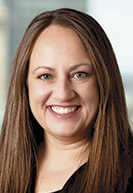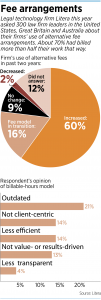Subscriber Benefit
As a subscriber you can listen to articles at work, in the car, or while you work out. Subscribe NowBilling by the hour has long been the standard pay arrangement between most lawyers and clients. That norm isn’t likely to end anytime soon, but more and more law firms are offering other payment arrangements.
Over the past 20 years, in Indiana and across the country, it’s become increasingly common for clients to request what are known as alternative fee arrangements, or AFAs, in place of billable hours. AFAs can take a dozen or so different forms, including billing a flat rate per day/week/month of work; having agreed-to flat rates for specific work like property tax appeals or patent applications; or taking payments over time, where the lawyer keeps track of the time by the hour and the client agrees to pay a flat fee per month until the bill is paid.
A 2024 global survey of 300 law firms by Litera, a Chicago-based legal-software technology company, found that 60% of respondents have increased AFA usage in the last two years. For 70% of the firms surveyed, nearly half or more of their work is now AFA-based.
“Client satisfaction is the primary factor influencing a shift towards AFAs, which are perceived as client-centric and value-driven rather than time-driven,” Litera reported. “And, with 64% of respondents favoring phasing out billable hours, we should expect to see more firms shift in this direction. Flat fees are the most popular choice among alternative fee arrangements, with a usage rate of 66 percent.”
A 2023 Bloomberg Law survey of more than 550 legal professionals found that just under a third of their work was performed under an AFA, and lawyers most often report using flat-fee AFAs over the past year. Flat fees, blended rates, fixed fees by matter, retainers and fee caps were the most common alternatives to billable hours.
One more: Thomson Reuters Institute reported that, in 2020, the True Value Partnering Institute, in collaboration with Massachusetts-based BTI Consulting, held the Law Firm Alternative Fee Arrangement Awards, recognizing 22 firms cited for excellence in integrating AFAs into their legal-service delivery models. Greenville, South Carolina-based Ogletree Deakins, which has an office in Indianapolis, was among six firms designated “AFA Powerhouse Law Firms.”
“Every sign we get in our research shows that alternative fees and pricing are going to be more important than ever as [law firms] try to prepare for what they anticipate will be a record caseload,” Michael Rynowecer, president and founder of BTI Consulting, said at the time.
The purpose of AFAs is largely to control costs. Indianapolis-based Barnes & Thornburg says on its website that it partners “with client stakeholders at the matter level to determine pricing, timing, outcomes and process expectations—resulting in cost certainty for clients. It’s the wave of the future in legal operations … and it’s happening right now.”

A quick survey of Indianapolis law firms suggests that AFAs are in use—and have been for some time—but they’re still a minor part of business. C.W. Raines, chief operating officer of Dentons Bingham Greenbaum in Indianapolis, remembers a client with an AFA back in 2002. “I think there were multiple [clients],” he said, “because I know I worked on a client back then, and they remain a client today still.”
That said, he estimated that AFAs account for less than 10% of client engagements.
“Billable hours are a good metric to measure productivity of our attorneys, whether they’re partners or associates,” Raines said. “So that metric will probably be around for some time. Of course, we measure revenue that’s generated within the firm, too, and who’s responsible [for it].”
“That billable hour is a tough one to get away from,” he added—in part, because billable hours are comparatively easy to measure. Lawyers do the work and track their time. Simple enough.
With AFAs—a flat fee, for example—the firm and its attorneys are estimating how long it will take to complete the work.
“So, it’s very difficult at times to quote that accurately, and sometimes we win and we do an OK job, and other times we are focused more exclusively on the client win, even if it becomes a loss-leader for us. So, those are kind of the pros and cons on our side.
“Dentons is very focused on delighting our clients, on representing them and making sure they have good outcomes and feel comfortable with us in whatever the representation is, so they come back to us for more,” Raines said. “It’s a very rudimentary business model.”
Tom Froehle, chair emeritus of Faegre Drinker and partner in Indianapolis, said some of the firm’s practices have been using contingent fees or fixed fees for decades when dealing with certain matters. But it’s been within the last 15-20 years that clients have become more interested in a wider variety of alternative fees. He estimated that 20% of the firm’s clients are on some kind of AFA.
“We now have a whole team of people who are focused on helping us work with clients to develop pricing strategies and structures that are different from just the billable hour,” he said, adding that “it’s really all about trying to be responsive to clients.”
Lyndsay Capeder, chief client and innovation officer in Taft Stettinius & Hollister’s Minneapolis office, said in an email that clients inquire from time to time about alternative fee arrangements.
“We treat these types of requests as an opportunity to better understand our client’s goals and objectives,” she said, adding that usually what the firm finds is that the client is looking for more predictability and transparency with their legal fees. “I’ve seen several situations where a client’s budget or AFA-related request is solely focused on individual attorney rates, and there is a missed opportunity for clients here—Taft’s talent and ability to strategically staff and manage matters are cornerstones in providing the most value to our clients.”
Fair pricing

Cari Lynn Sheehan, who teaches professional responsibility at the Indiana University Robert H. McKinney School of Law in Indianapolis and is a conflict attorney with Indianapolis-based Scopelitis Garvin Light Hanson & Feary, said law firms must comply with Rule 1.5 of the Rules of Professional Conduct, which begins: “A lawyer shall not make an agreement for, charge, or collect an unreasonable fee or an unreasonable amount for expenses.”
“As long as we meet that standard, then attorneys can charge how they want, whatever they want,” she said.
Sheehan said AFAs provide a sense of security for clients.
“It’s a sense of feeling that they’re getting a better deal, not overpaying for work. And then, too, just having their attorneys accessible more often, depending on what type of rate they have or depending on what type of alternative rate they’re doing,” she said.
Patrick Olmstead, who chairs the Indiana Bar Association’s Legal Ethics Committee and has his own firm, Patrick Olmstead Law, in Greenwood, tells this story about alternative fee arrangements:
A man wanted to file a lawsuit because he believed gases from a newly installed laminate floor were making him sick. The man asked Olmstead to take the case on contingency—no money unless he won the case. Olmstead said he would take the case for $2,000 upfront for legal work that probably would have cost around $5,000 if billed by the hour.
Olmstead reached out to an expert who examined a sample of the flooring and was unable to detect any gas. “Nice thing is, I didn’t take a zero,” he said. “But I had to end up telling him, we got it analyzed [and] evaluated his case for $2,000. That wasn’t a bad result for him, either.”
“Ultimately,” Olmstead said, “what you want is for things to be fair and palatable to each client and the lawyer. At the end of the day, you don’t want to charge your client what they can’t afford.•
Please enable JavaScript to view this content.

